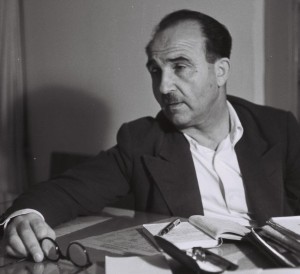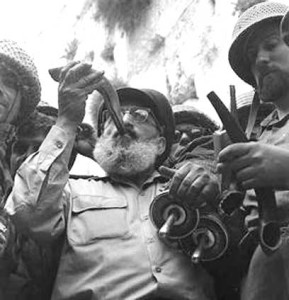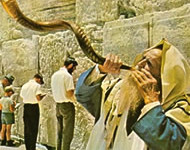
Israel marks the anniversary to the unification of Jerusalem. Read about the liberation of the city and the letter sent by Prime Minister Eshkol to Jordan’s King Hussein stating that Israel would take no actions against him if he ceased hostile activities.
1967 Six-Day War
Arab terrorist escalated their raids across the Egyptian and Jordanian borders, along with persistent Syrian artillery bombardment of agricultural settlements in northern Galilee and massive military build-ups by the neighboring Arab states. When Egypt again moved large numbers of troops into the Sinai desert (May 1967), ordered the UN peacekeeping forces (deployed since 1957) out of the area, reimposed the blockade of the Straits of Tiran and entered into a military alliance with Jordan, Israel found itself faced by hostile Arab armies on all fronts.
As Egypt had violated the arrangements agreed upon following the 1956 Sinai Campaign, Israel invoked its inherent right of self-defense, launching a preemptive strike (5 June 1967) against Egypt in the south, followed by a counterattack against Jordan in the east and the routing of Syrian forces entrenched on the Golan Heights in the north.
At the end of six days of fighting, previous cease-fire lines were replaced by new ones, with Judea, Samaria, Gaza, the Sinai peninsula and the Golan Heights under Israel’s control.
At the end of six days of fighting, previous cease-fire lines were replaced by new ones, with Judea, Samaria, Gaza, the Sinai peninsula and the Golan Heights under Israel’s control. As a result, the northern villages were freed from 19 years of recurrent Syrian shelling; the passage of Israeli and Israel-bound shipping through the Straits of Tiran was ensured; and Jerusalem, which had been divided under Israeli and Jordanian rule since 1949, was reunified under Israel’s authority.
Battle of Jerusalem
The battle of Jerusalem began on the morning of June 5, 1967 when the Jordanians opened fire along the entire cease-fire line. By that afternoon the Jordanians occupied the Governor’s Palace. The Central Command of the Israeli Army, under the command of General Uzi Narkiss, moved the “Har’el” brigade to the Jerusalem front. This force tore through the enemy positions of “Har Adar” and “Abdul Aziz” and conquered “Nebi Samuel”.
By the morning of June 6 this force reached the Jerusalem-Rammalah road and stormed “Tel-El” and “Givat HaMivtar”. In addition a paratroop brigade was moved up. Its instructions were to open the way to Mount Scopus and the Rockefeller Museum in order to position themselves to break through to the “Old City” of Jerusalem on very short notice.
The way to Mount Scopus was now cleared and the northeast section of Jerusalem was liberated.
This force cut through the front line of the town and occupied the Police Academy, Ammunition Hill, Mandelbaum Gate, the American quarter and “Wadi Jos”. The way to Mount Scopus was now cleared and the northeast section of Jerusalem was liberated.
Jordanian King Hussein’s Role
When the war began, Israel did its best to avoid conflict with Jordan. But on the morning of June 5, 1967, the Jordanian army bombed West Jerusalem, the suburbs of Tel Aviv, as well as targets in the Galilee. Prime Minister Eshkol sent King Hussein a letter stating that Israel would take no actions against him if he ceased hostile activities. Jordan, however, received misinformation of Arab victories emanating from Cairo, and pressed forward. They sent troops to Mount Scopus and government hill ridge in Jerusalem. The Jordanian forces might have faired better, if not for the Israeli discovery of a major Jordanian intelligence blunder. Indeed, Jordanian radio broadcast its military plans roughly an hour ahead of the actual deployment.
Prime Minister Eshkol sent King Hussein a letter stating that Israel would take no actions against him if he ceased hostile activities.

After several decisive victories on the battlefield, Eshkol made one final attempt to end Jordanian-Israeli hostilities. He sent Hussein a letter asking that he recall his troops. If Hussein would comply, Israel would not take control of the old city of Jerusalem. Eshkol’s call went unanswered. The Central Command activated the paratroop brigade that had conquered the Mount of Olives and the Mount Scopus ridge. These troops broke through to the ‘Old City’ by way of the Lions’ Gate and hoisted the Israeli flag over the Western Wall (the last surviving remnant of the Second Temple), and Jerusalem has been in Israeli hands ever since.
Jerusalem Day

Following the 6-Day War victory, on June 27, 1967, the Government presented the Knesset with three law proposals. These proposals determined the effective unification of Jerusalem and sanctioned the application of Israeli law in the entire area of the unified city. The municipal boundaries of the city were altered and its area was increased threefold: from 38,100 dunams to 110,000 dunams. At the same time a law was adopted that enabled free access to the holy places by the members of every religion. In 1980, the Basic Law: Jerusalem was adopted. This law determined that Jerusalem was the capital of Israel and the location of all state authorities.
On May 12, 1968, the Government decided to make the 28th of Iyar the symbolic holiday, Jerusalem Day , a day that symbolizes the continued historical connection of the Jewish People to Jerusalem. Thirty years later, this holiday became anchored in the law: On March 23, 1998, the Knesset passed the second and third readings of the “Jerusalem Day Law”, which determined that the date that the day Jerusalem was liberated during the Six-Day War was now a national holiday.




